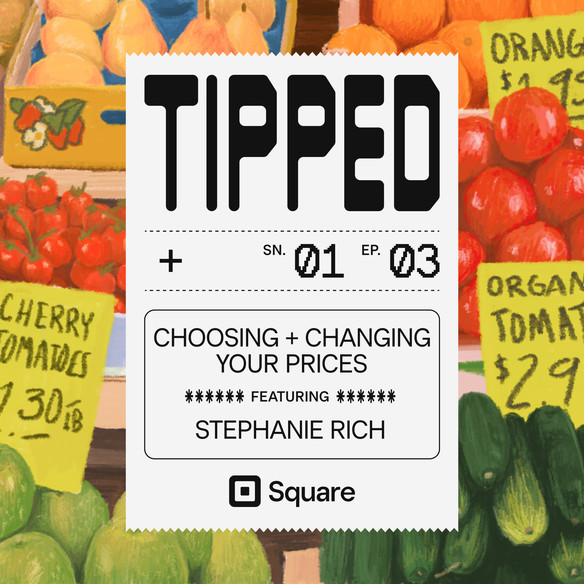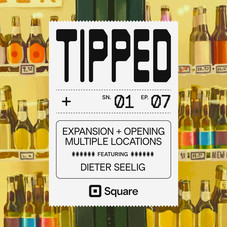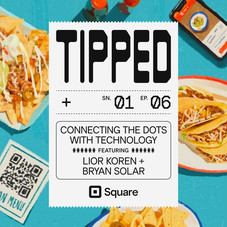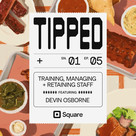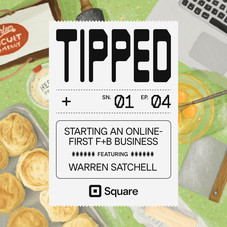Table of contents
It’s important for every business to get their pricing strategy right, but it’s complicated to figure out exactly what that means for your business and your customers. Ultimately, finding the perfect balance among overhead costs, food costs, and profit margins is a numbers game.
Stephanie Rich, owner of Verdine in Houston, TX, has had a lot of practice choosing and changing menu prices for everything from food trucks to full-service restaurants. In this episode of Tipped, she shares her best tips for what you need to consider when setting your menu prices and to how to inform customers about the food they’re paying for.
Read some of her best tips below and listen to Tipped for more of Stephanie’s advice.
3 tips from Stephanie Rich of Verdine on choosing and changing your prices
- Be transparent about pricing with your customers: “You can’t lower the true cost of food that you have to pay. There’s nothing you can do about that, but you can educate your customers about [your products], what’s special about them. What’s unique, why it costs what it does. Does it take you 20 hours to make one cookie? Tell them that. Are you making everything from scratch? Are you using organic ingredients? Are you using the best butter out there? Put out a sign, put up that information, try to get that across to customers.”
- Know what it costs to run your business: “It’s the internet, it’s the phone, it’s the workers. Workman’s comp, it’s the business insurance, Amazon prime subscription, it’s the music subscription … [you have to] understand what everything costs and what goes into running your business at the end of the day and how much money you have to spend as a business owner. You turn the lights on and keep the lights on, and then everything on your menu needs to be able to pay for that. Because that’s the only way you make money.”
- Be flexible with your menu: “Look at the grocery store and what’s on sale. [For example], I have regular items, but I have specials. So if sweet potatoes are on sale, great, that’s what I’m buying and that’s gonna be stuffed into my taco or my empanada. I can use what’s on sale and in season because that would be a lower food cost.”
Full Transcript
Hi, and welcome to Tipped, a Square podcast. Defining your prices often goes hand in hand with identifying your target customers. Today, we’ll dive deep on the ins and outs of how to choose your prices to attract the customers you want, adjust for supply chain challenges while, also keeping the health and growth of your business in mind.
Stephanie Rich: I started my journey in the food and beverage space after graduating from graduate school as a registered dietician with a master’s degree in science.
That’s Stephanie Rich, owner of Verdine, a brick-and-mortar plant-based restaurant in Houston, Texas.
Stephanie Rich: I started kind of a side hustle selling my vegan creations and my vegan food at a farmer’s market table on the weekends. And I just that being vegan at that time for about 10 or so years, that truly there was someone else in Houston that wanted to eat the way I wanted to eat. So, I felt like who else better to do it than me. So, I set out to create healthy plant-based, all vegan, ready to eat meals. I served them at the weekly farmer’s market and I loved it. After six months, I quit my job as a dietician to focus on my business full time, so I could take on caterings. So I could expand to two other farmers markets. And about a year of doing that, I opened my food truck.
I ran my food truck for five years and always with the goal of the food truck was to open a brick-and-mortar restaurant, which I was able to do in April of 2019. So I went from farmer’s market, to food truck, to restaurant in the past decade. And I will say, you kind of get into it for the food and the passion of feeding people. And as a restaurant owner, you slowly realize that’s a tiny part of what you do.
Food and beverage business owners are used to that heavy task load and making big decisions every day. One of those big tasks that is a part of running a business is figuring out how to set fair and sustainable prices that keep your customers happy and your business healthy.
Stephanie Rich: I owned a food truck and operated a food truck for five years before going brick-and-mortar. So my food truck prices were significantly lower and there’s a lot of reasons for that. My overhead was significantly lower, right? I was the one taking your order and I would turn around and make your food. You know, there wasn’t the same level of rent, there wasn’t the same level of cleaning supplies. There wasn’t employees, there wasn’t a dishwasher lease, there wasn’t an ice machine lease. I mean, we can go on and on. So obviously the cost of food is a huge factor in what goes on the menu, right? But that’s a tiny portion of it. It’s everything else, it’s all of the overhead. It’s the internet, it’s the phone, it’s the workman’s comp, it’s the business insurance.
It’s my Amazon Prime subscription, it’s the music subscription, it’s everything. I think that doesn’t translate to the customer, right? It’s oh, I can buy a head of cauliflower for 2,89 at the grocery store. So why would I pay $12 for a quarter of a head in a bowl? Well, you’re paying for the bowl you’re eating out of, you’re paying for the person that ran in your order. You’re paying for the spray bottle of cleaning supplies that we spray down on the table after you leave. So it’s really understanding what everything costs and what everything goes in to run your business at the end of the day. Like how much money do you have to spend as a business owner to turn the lights on and keep the lights on, and then everything on your menu needs to be able to pay for that, because that’s the only way you make money.
So it’s really wild actually, when you think about it that way. Obviously, we aim like most restaurants to keep our food costs in between that magic 30%, like 35% us being vegan. A lot of the vegan products, be it the Beyond meat, the vegan brand cheese, they are actually way more expensive per pound or per ounce than the animal-based products. Their food costs alone are just intrinsically higher. There’s a few reasons for that, right? There’s no government subsidies for those products. So they’re higher, they’re smaller businesses. So they don’t have as much of demand or as like kind of the mainstream animal products, right? So there’s a lot of factors and reasons that go into that. And then that gets trickled down to us, which then of course gets trickled down to the customer.
So everything is really interconnected that way. But, so we try to keep that food cost magic number in between 30 and 35%, which has been incredibly hard. And we haven’t been the best at doing that, despite our prices. And then also manage customers’ expectations. We could make a pizza, let’s say with that food cost in that magic range that we like, but then the pizza would be $29. Okay, we can’t serve that pizza or okay, we can’t serve that entree, whatever it is because we know our customer, isn’t interested in spending $29 on whatever food I have, is. So we’ve got to go back to the drawing board and rethink, is there a different ingredient we can put in here? Is there a different entree we can do instead? So with that, we’re kind of keeping both sides of the equation happy.
Between rising prices, supply chain outages, and managing consumer expectations. Striking the right balance can sometimes be a challenge.
Stephanie Rich: Every business is getting hit with inflation or with higher prices, whatever you want, supply chain issues, kind of whatever you want to call it. And it gets pushed on us. And so if it costs us more money to keep the lights on, and the only way we can pay to keep the lights on is by serving a burger, an entree, a salad or whatever that has to go up. It’s just simple math. So that’s been hard and that’s been something of a challenge and something that I don’t know if we’re necessarily the best at, I mean, it’s kind of a buzzkill, right? You’re going into a restaurant and you don’t want to read a sign that says, by the way, avocados a case went from $50 a case to a $100 a case. So now we’re charging $3 instead of $2 for an avocado, which that’s not even a made up example, that’s real life.
As a customer, you don’t want to walk into restaurant and see that sign. And side note, we as humans, we don’t really read, signs are in front of our face all day long and it’s being a restaurant owner, a business owner, you kind of learn a little bit about human psychology, just inadvertently. You do your best to educate, but you also have to know that you can repeat it a million times, you can put it everywhere. But not everyone’s going to get the message, not everyone’s going to see it. And so if there were to be someone that really had an issue with something, when it comes to price or cost, as a restaurant owner, I’m very available to my guests and customers and my managers know that. They give out my email, someone can contact me directly and I’m happy to explain to them and have a conversation with them about what’s going on. If someone were to truly be that bothered or upset by whatever the issue is price related or otherwise.
We asked Square business owners to submit their most pressing questions for our guests. Today’s question is from Karina’s Confectioneries in Orlando, Florida. “I operate my bakery out of a commissary kitchen, which means I don’t have a whole lot of storage space and thus, can’t make and save on bulk purchases. I also don’t have high volume sales, so a lot of my perishables go bad before I can finish using them. Because of this, my food costs are pretty high and I have to buy dairy and other perishables from the grocery store as needed. What is your advice for those of us in this situation? As we try to grow our businesses, lower our food costs and minimize our food waste”.
Stephanie Rich: So what I would say is I totally understand the situation. I felt like I was in a similar situation when I had my food truck, right. I was super scrappy and I did all my food preparation on the food truck. So I didn’t have to pay a commissary. I had literally just a small reach-in refrigerator on my truck. I would look at the grocery store, what was on sale. My food truck, I had flexibility with what I could serve. So I had some regular items, but then I did have specials. And so what was on, oh, sweet potatoes are on sale, great. That’s what I’m buying and that’s going to be stuffed into my taco or my enchilada or how can I use what’s on sale and what’s in season, because that would be obviously a lower food cost there.
Depending on what you do, right? I know confection, so it sounds maybe like some sort of bakery. You can’t lower your food costs necessarily. You can’t control how much flour costs, or how much dairy it costs, or how much… You don’t really have control of that. But again, what you do have control of is your education in your marketing.
Our next featured business owner question. “With everything escalating in price and being in a tough economic time. How do you manage pricing while, avoiding continuous price raises that might affect customer retention”?
Stephanie Rich: When we use organic, I point it out, right? When we’re making something from scratch, I point it out so that you’re trying to get that value, right? Get all your bonus points you can. It costs that much because it takes that long or me to do it, right? It costs that much because that’s how much it costs. I can’t do it in two seconds, I can’t make it for free. So there is a cost to everything and again, sometimes you’re not going to win everybody over. Sometimes again, someone’s going to complain about it because they want to. So do what you can be, scrappy, look for sales, look for ways to use ingredients that are on sale.
You can’t lower the true cost of food that you have to pay. There’s nothing you can do about that, but educate your customers about what you’re putting in. You know, what’s special about it, what’s unique, why it costs what it does. Does it take you 20 hours to make one cookie? Tell them that, are you using something special in your butter or your flour? Give them the reason why it costs, what it does and your true customers are going to understand that and support you.
We asked Stephanie to pass on the best tips she’s learned from her experience in the food and beverage industry.
Stephanie Rich: I don’t know if this is necessarily advice, but what I would say if you’re new at this, or if you’re considering going into the industry, really ask yourself, do you like people? Do you want to work with people? And do you like solving problems? Because, it almost is sometimes more about that. So if you like that, every day up and down kind of uncertainty, if you like solving problems, if you like talking to people, if you have good people skills, then those kinds of things, I feel like is what it is truly like to be a food and beverage business owner. I love the food part of it obviously, I do love the people that connect with our food and that appreciate what we’re doing. I’ve been very lucky to have some of my same customers from when I started out on that farmer’s market table, to today in the restaurant.
But it is really fun connecting with those people who get it, who get what we do and who are appreciative of what we do. It’s a really rewarding feeling that like you’ve done something right. And that you saw something in the world that should exist and someone else recognizes it and wants to support it too. Ultimately, I think that’s been the funnest part and the most rewarding part about it, because that’s really what this was for me. It was a passion that I wanted to put more of this type of food out into the world. I felt this style of restaurant needed to exist in Houston and really everywhere, and it didn’t. And so I wanted to create that and having people recognize that and support it like ultimately is that’s been the most rewarding part.
Thank you to Stephanie Rich for her time and insights for our show today. Stephanie is the owner and founder of Verdine, located in Houston, Texas. If you want to hear more like this, make sure to subscribe, to Tipped on Apple podcast, Spotify or your podcast app of choice. You’ve been listening to Tipped, a Square production. This episode was produced by Kaitlin Keefer and Clara Shannon. Our music was composed by Jordan Wallace, with sound recording by Sorrentino Media and D.R. Baker. Thanks for listening.
![]()

